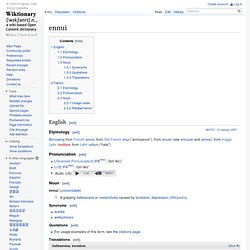

Define: fungible. Define: stochastic. Jejune. Quine. Aphasia. Define meretricious. Agalmatophilia. Clinical study[edit] Agalmatophilia became a subject of clinical study with the publication of Richard von Krafft-Ebing's Psychopathia Sexualis.

Krafft-Ebing recorded an 1877 case of a gardener falling in love with a statue of the Venus de Milo and being discovered attempting coitus with it.[2] Fantasy, transformation, role-play[edit] An important fantasy for some individuals is being transformed into the preferred object (such as a statue) and experiencing an associated state of immobility or paralysis. Such fantasies may be extended to role-playing, and the self-coined term used by fetishists who enjoy being transformed into what appears to be a "rubber doll" or "latex doll". Samizdat.
Samizdat (Russian: самизда́т, IPA: [səmɨzˈdat]) was a key form of dissident activity across the Soviet bloc in which individuals reproduced censored publications by hand and passed the documents from reader to reader.

This grassroots practice to evade officially imposed censorship was fraught with danger as harsh punishments were meted out to people caught possessing or copying censored materials. Vladimir Bukovsky summarized it as, "I myself create it, edit it, censor it, publish it, distribute it, and get imprisoned for it. "[1] Zaibatsu. Terminology[edit] Although zaibatsu existed from the 19th century, the term was not in common use until after World War I.

By definition, the "zaibatsu" were large family-controlled vertical monopolies consisting of a holding company on top, with a wholly owned banking subsidiary providing finance, and several industrial subsidiaries dominating specific sectors of a market, either solely, or through a number of subsubsidiary companies.
Significance[edit] The zaibatsu were the heart of economic and industrial activity within the Empire of Japan, and held great influence over Japanese national and foreign policies. Three Worlds Theory. The Three Worlds Theory (simplified Chinese: 三个世界的理论; traditional Chinese: 三個世界的理論; pinyin: Sān gè Shìjiè de Lǐlùn), developed by Chinese Communist leader Mao Zedong (1893–1976), posited that international relations comprise three politico–economic worlds: the First World, the superpowers; the Second World, the Soviet allies; and the Third World, the nations of the Non-Aligned Movement[1] .

Notably, Chairman Mao included the US and the Soviet Union in the First World group of countries. In 1974, then Chinese Vice-Premier Deng Xiaoping (1904–97) explained the Three Worlds Theory in a speech to the United Nations, justifying China's cooperation with non-communist countries. Galácticos. Worldbuilding. Worldbuilding or conworlding is the process of constructing an imaginary world, sometimes associated with a whole fictional universe.[1] The resulting world may be called a constructed world.

The term "worldbuilding" was popularized at science fiction writers' workshops in the 1970s. [citation needed] Developing an imaginary setting with coherent qualities such as a history, geography, and ecology is a key task for many science fiction or fantasy writers.[2] Worldbuilding often involves the creation of maps, a backstory, and people for the world. Constructed worlds can enrich the backstory and history of fictional works, and it is not uncommon for authors to revise their constructed worlds while completing its associated work. Constructed worlds can be created for personal amusement and mental exercise, or for specific creative endeavors such as novels, video games, or role-playing games. Methods[edit] Captain of industry. Acrostic. An acrostic is a poem or other form of writing in which the first letter, syllable or word of each line, paragraph or other recurring feature in the text spells out a word or a message.[1] The word comes from the French acrostiche from post-classical Latin acrostichis, from Koine Greek ἀκροστιχίς, from Ancient Greek ἄκρος "highest, topmost" and στίχος "verse").[2] As a form of constrained writing, an acrostic can be used as a mnemonic device to aid memory retrieval.

Overview[edit] Relatively simple acrostics may merely spell out the letters of the alphabet in order; such an acrostic may be called an 'alphabetical acrostic' or Abecedarius. Caliphate. Alignment (Dungeons & Dragons) In the Dungeons & Dragons (D&D) fantasy role-playing game, alignment is a categorization of the ethical (Law/Chaos axis) and moral (Good/Evil axis) perspective of people, creatures and societies.

The earliest edition of D&D allowed players to choose among three alignments when creating a character: Lawful, implying honor and respect for society's rules; chaotic, implying the opposite; and neutral, meaning neither. Advanced Dungeons & Dragons (AD&D) introduced a second axis of Good, Neutral and Evil, offering a combination of nine alignments.[1][2] The D&D Basic Set retained the system of three alignments, keeping it through the D&D Rules Cyclopedia. The nine alignments can be represented in a grid, as follows: This schema of nine alignments was used throughout the original AD&D and the second edition of AD&D, as well as the successor game, the third edition of D&D. Batman (military) A batman (or batwoman) is a soldier or airman assigned to a commissioned officer as a personal servant.

Before the advent of motorized transport, an officer's batman was also in charge of the officer's "bat-horse" that carried the pack saddle with his officer's kit during a campaign. The term is derived from the obsolete bat, meaning "pack saddle" (from French bât, from Old French bast, from Late Latin bastum), and man. A batman's duties often include: Sacrifice. Devaloka. To Hindus, Devaloka is a plane of blissful existence that can be reached as soon as one is sufficiently attuned to light and good.

However, to become even better and to learn more, one must return to a life on Earth, until all the learning possibilities here have been exhausted. Then, any other lives become unnecessary and liberation (moksha) is achieved. Ennui. English[edit] Etymology[edit] Borrowing from French ennui, from Old French enui (“annoyance”), from enuier (see ennuyer and annoy), from Vulgar Latin inodiare, from Latin odium (“hate”)

Phrygian cap. History[edit] Antiquity[edit] The Phrygian cap is sometimes associated with the headdress that was worn by King Midas to hide the donkey ears given to him as a curse by Apollo, although according to Ovid, Midas hid his ears beneath a purple turban.[2] Phrygians, however, were shown wearing the distinctive peaked cap in illustrations on Greek vases,[3] and such images predate the earliest surviving literary sources: a mid-6th-century Laconian cup depicts the capture of Silenus at a fountain house, by armed men in Eastern costume and pointed caps.[4] In the later parts of Roman history, the god Mithras — whose worship was widespread until suppressed by Christianity — was regularly portrayed as wearing a Phrygian cap, fitting with his being perceived as a Persian god who had "come out of the East". The Macedonian, Thracian, Dacian and 12th-century Norman military helmets had a forward peaked top resembling the Phrygian cap called Phrygian type helmets.
White elephant. The British East Africa Company came to regard Uganda as a white elephant when internal conflict broke out in 1892 and rendered the company ineffective in administration of the territory. A white elephant is an idiom for a valuable but burdensome possession of which its owner cannot dispose and whose cost (particularly cost of upkeep) is out of proportion to its usefulness or worth. The term derives from the story that the kings of Siam (now Thailand) were accustomed to make a present of one of these animals to courtiers who had rendered themselves obnoxious, in order to ruin the recipient by the cost of its maintenance. In modern usage, it is an object, scheme, business venture, facility, etc., considered without use or value.[1] Background[edit] Pareidolia. Apophenia. Mondegreen. A mondegreen is the mishearing or misinterpretation of a phrase as a result of near-homophony, in a way that gives it a new meaning.
Mondegreens are most often created by a person listening to a poem or a song; the listener, being unable to clearly hear a lyric, substitutes words that sound similar, and make some kind of sense.[1][2] American writer Sylvia Wright coined the term in her essay "The Death of Lady Mondegreen", published in Harper's Magazine in November 1954.[3] "Mondegreen" was included in the 2000 edition of the Random House Webster's College Dictionary. Merriam-Webster's Collegiate Dictionary added the word in 2008.[4][5] The phenomenon is not limited to English, with examples cited by Fyodor Dostoyevsky,[6] in the Hebrew song "Háva Nagíla" ("Let's Be Happy"),[7] and in Bollywood movies.[8] A closely related category is soramimi—songs that produce unintended meanings when homophonically translated to another language.[9] Etymology[edit] "I know, but I won't give in to it.
Rogues gallery. A rogues gallery (or rogues' gallery) is a police collection of pictures or photographs of criminals and suspects kept for identification purposes. Soramimi.